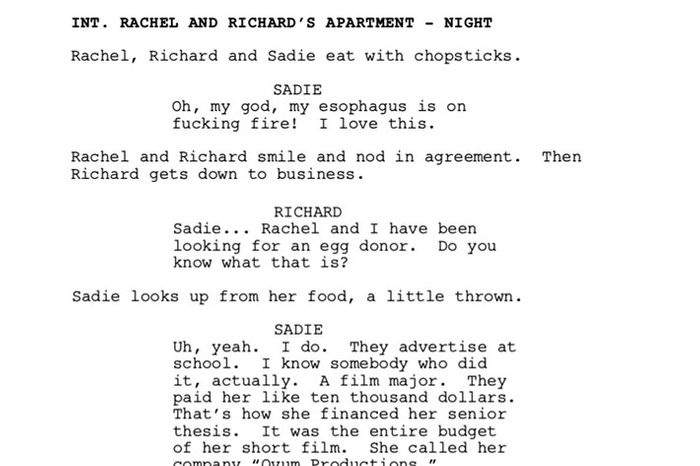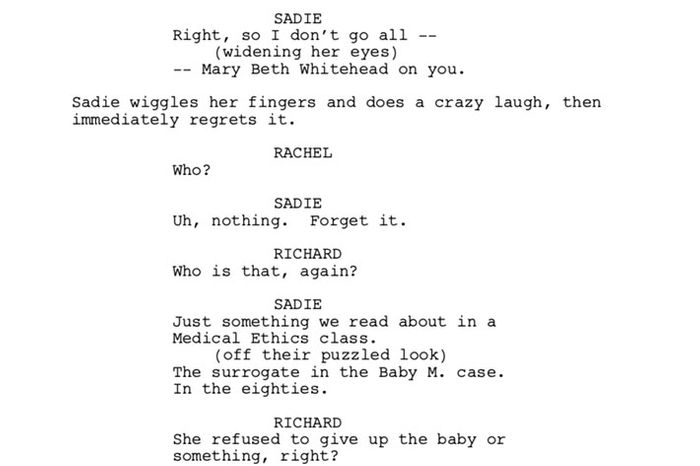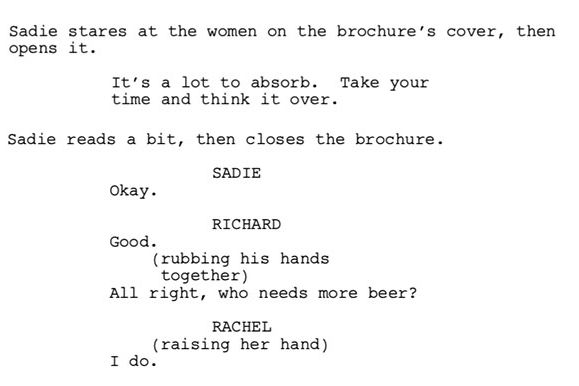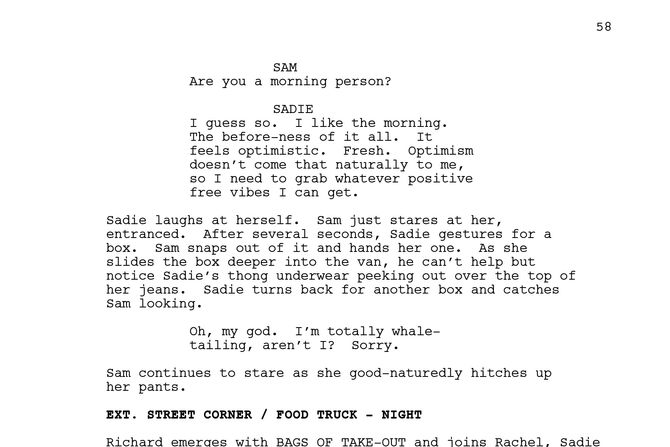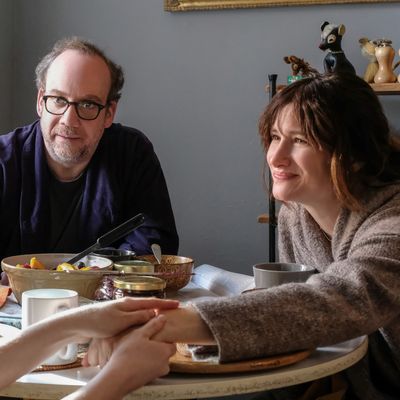
Once again, Vulture is speaking to the screenwriters behind the awards season’s most acclaimed movies about the scenes they found most difficult to crack. For this installment, Private Life writer and director Tamara Jenkins discusses a pivotal scene in her fertility-focused comedy: the scene in which Richard (Paul Giamatti) and Rachel (Kathryn Hahn), who have been struggling to have a baby, finally work up the nerve to ask their niece Sadie (Kayli Carter) if she would be willing to donate her eggs to them. It’s a scene whose repercussions tumble out over the second half of the film, as all three characters grapple with the implications of such an undertaking not just for themselves, but for their entire family for years to come. But first things first: popping the question.
I guess the question that I always ask myself when writing a scene is, What would really happen? What do people actually say? How would Rachel actually ask Sadie for her eggs? It’s not something that people often ask each other. So how do you do it?
At this point in the film, Rachel and Richard have already fucked up — they bring up the subject of eggs in an earlier scene, and Sadie thinks they’re talking about breakfast, and they give up. So by the time they get to the top of this scene, they are just like, “Okay. You’ve heard about egg donation, right?” It’s a different line of attack. But then, once they ask, they’re totally walking on their toes because, again, there’s really no way to ask someone something like that.
That whole untrodden aspect is what was attractive to me to write. There’s no set way to have these conversations. There’s no map for it because it’s so strange. It’s so under-expressed, it’s outside of the realm of etiquette. Those are things that draw me to scripts in the first place.
I was terrified about writing a 20-something-year-old character, because it seemed so hard to not make it sound like a 50-year-old’s idea of a 25-year-old. I remember being really paranoid that Sadie was gonna sound like an idiot, or just wrong. So I walked around the city eavesdropping on kids, like 20-somethings. I mean, I’m very into eavesdropping, as a technique. I like to write down things that I’ve eavesdropped in general.
I remember vividly my husband’s niece coming to visit us. She was nothing like Sadie — she went to Brown; she was a rower. She was the opposite of a Bard dropout. But she bent over to get something in her purse at one point and turned around to me and said, “Oh my God, I’m whale-tailing, aren’t I?” And I was like … “I’ll be right back. I have to go write that down.” I’d never heard that in my life. Is that how people talk at Brown? I don’t know. But it was the funniest thing I’d ever heard. And now it’s in my movie.
But also, at that age, there’s this way in which you’re still so close to your education. Like the way Sadie talks about media studies. She’s still thinking in that academic way, and trying to apply what she’s learned to real life, and regular people don’t think that way. Everything she says is thoughtful, but it’s still entrenched in this academic mind-set. That was something else I overheard — somebody was taking a class called “Media and Consumer Society,” or something like that. And then I went online and looked up classes at Bard. And I started thinking … yeah. That kind of class. That’s the way this kid thinks.
There was this billboard up in the Lower East Side that actually said “Live Like a Rockefeller. Party Like a Rock Star.” I took a picture of it because it was so obscene. It was an advertisement for the Ludlow or something — one of the first towers that were going up in the Lower East Side. I just remember thinking it was the end of the world. And then it found its way into the script.
But then I had to come up with so many different variations on it because every time I had one, for some reason, we were in legal trouble. I loved the original version, and it’s in the script, but we weren’t allowed to use it in the final cut. So I tried “Live in Luxury. Rock Like a Ramone,” and then I had to write to the Ramones — I wrote this letter to Marky Ramone, trying to explain how much I loved the Ramones, but how they had been co-opted as a kind of cultural touchstone and were being used as a sales point for these luxury condos. I felt like I was writing to them in the voice of Sadie, actually.
And, ultimately, they said no. They didn’t even want to be associated with a fictional condo. It was really disappointing. So then I landed on “Live in Luxury. Party like a Punk,” which is what’s in the film. And it’s pretty good. But … I liked the Ramones reference a lot.
For Sadie to be like, “Oh my God, a lot of people do that at my school. There’s, like, signs up all over the place” — that kind of generational clash is really interesting to me. She’s so casual about it — “Oh, yeah, everybody does it. They have flyers. My friend did it.” It’s not a heavy idea to Sadie yet, in the same way it is for Richard and Rachel. And that’s the difference between the way they’re talking about it and the way that she’s talking about it.
And then the Ovum Productions thing — that was made up for the script. But then you have to create your own company when you make a movie, and one of the producers was like, “Why don’t we name our LLC Ovum Productions?” And we became Ovum Productions.
I spoke to somebody recently who had seen my movie, and she said, “Oh my God, these people are so horrible for asking this young woman to do this.” She had a moral reaction that was really intense. But when you’re writing something like this, you have to put yourself in the shoes of each person. You really have to make yourself familiar with each person’s perspective and know what each of them would do in any given situation, and let them play out believably. You have to treat each person’s point of view with dignity, even if it’s not your personal point of view.
So, for example, I never wanted Molly Shannon’s character to be just a nay-saying bitch of a mother. And likewise, I don’t think Rachel and Richard are going into this thinking that they’re going to exploit Sadie. The business of egg donation is inherently exploitative in a way, but it’s this mutual exploitation. That’s why it’s complicated. And Rachel and Richard are very worried about coming off as predatory or opportunistic. The whole movie is about the moral anxiety of this enterprise that they undertake.
It’s called the MMPI — Minnesota Multiphasic Personality Inventory. It’s this personality test to make sure that the person is psychologically stable. Social services uses them, obviously. (If you’ve seen Leave No Trace, it’s the same test Ben Foster’s character takes in that film.) And they use that for these kinds of situations, too, to make sure that the person is a good candidate for a procedure.
For the scene later on when Sadie actually takes the test, I went digging through the test, and I just lifted questions from several different versions. I don’t think I made any up. It’s a collage. But the questions were crazy like that. Like “Are you insane?” or “Do you like to smash things?” “Are you a singer?” It’s a very disparate set of questions, and you go through it thinking, “Which one will get me in trouble?” But you can’t outthink it because it’s so crazy.
I remember that when the script was too long, my husband was like, “Well, maybe you can get rid of the Mary Beth Whitehead thing,” because it doesn’t really come up again. But I just like that Sadie goes straight to the nightmare scenario, which of course she would. Not to be dark — she’s just so eager to share this thing she read about in her medical-ethics class. Like, she wasn’t a premed student. But she’s been in school for too long. She’s taken all these random classes. Too many classes.
It’s clearly a stupid thing to bring up in this situation, but again, it’s just a reflection of that way that you get overstuffed in school. And you’re constantly asked to synthesize all this information without any real-world experience to bring into it yet. Sadie hasn’t figured out how to suppress that urge yet.
They’re so relieved here. This was so hard for them to ask, and it didn’t work the first time. And they are just being so careful, and trying to be so measured in their presentation and clearly not wanting to coerce her into anything. They’re trying to do it the right way.
I read a lot of stuff about the ethics of doing intra-family egg donation, and there was a lot of very interesting stuff about the reasons people do go to a stranger. For one thing, you don’t have to ask for it; someone is already offering it. The transaction, theoretically, has a lot less weight.
Sadie’s attitude is, “What’s the big deal?” And of course, to her, what is the big deal? Later, when she’s 50, or when she’s 40, when she realizes that some of her genetic material is running around, it might mean more to her. But she’s not there yet. Developmentally, she is not there. But those are the people who provide eggs — inherently, because of their age, that’s the stage of life they’re in.
Sadie later tells her mom that it doesn’t matter because she’s not going to have kids. And her mom calls her out on it — like, what the fuck does she know? She doesn’t. But she might! I mean, there’s the possibility that she just knows herself that well, and that’s just not what she is going to want. But the absurdity and the whole biological tyranny of the female experience is that when someone like Rachel is ready to have a kid, it’s too late. For Sadie, she’s still so far away from feeling like she has to make that decision. But it’s so unfair. The biology of it is brutal, and it’s not really interested in your career.
A few scenes earlier, Rachel lies in bed at night and says, “Do you think we should do it? She’s so young.” And Richard says, “That’s the point.”
Do I think her saying “yes” so quickly makes them take a step back? I think it’s complicated because it’s something they want, but then they talk more and maybe start to realize that she doesn’t really understand what this is. She frames it at first as like, “I’m not doing anything else,” as if it’s a summer job.
But then she says, “You guys would be amazing parents.” And she herself begins to realize the gravity of what she’s giving, and they’re so moved. But everybody’s still trying to do this the right way. “We’re gonna talk to your parents. We’re gonna make sure they’re cool with this because this is not gonna be something we’re gonna go into thoughtlessly. This is gonna be a family thing.”
But Sadie continuing to shrug and say that it’s not gonna be a big deal — they’re sort of like, Really? I think that it’s the first mindfuck for them.
I’ve talked in the press about the fact that my husband and I went through our own version of Rachel and Richard’s situation, but that’s just the core of this story. Private Life is ultimately fiction.
The autobiographical element is a fixation with women writers. Like, when Jonathan Franzen wrote The Corrections … if a woman wrote that book, how much of the writing about it would be about “Is that your family? Is it autobiographical?” Whereas he was just considered a genius — which he was, and it’s a great book, and I love it. But nobody seemed to get as hung up on the degree to which it’s autobiographical. It was about the creation on the part of the author.
So when people ask, “Is this a memoir?” I’m like, “Only in its most essential element.” Like, you can’t just make shit up. It has to be true at some point. But if I were presenting this as my memoir, and if I made up as much as I did, I’d be in trouble. I would be like that guy who wrote A Million Little Pieces. I don’t have a Molly Shannon character in my life. I don’t have a Sadie character. Yes, my husband and I went through IVF, so I knew the emotional architecture of what something like this feels like, and I knew the anthropology of fertility clinics, and what those places felt like. But so have thousands of other people — at a certain point that’s just like saying I know what it feels like to be a human. That’s why there’s fiction. There has to be or these ideas wouldn’t have any shape.
Below, read the full scripted version of the scene:




